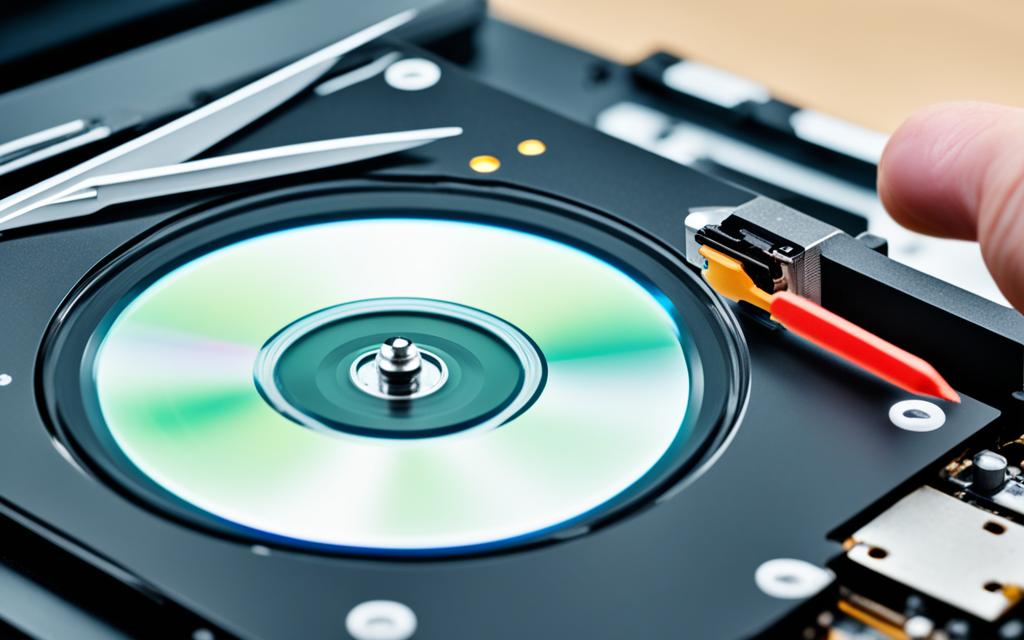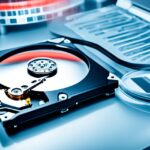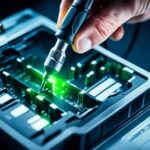Table of Contents
Nowadays, the reliability of your hard drive is crucial. It’s important to know how to check your HDD for bad sectors. Doing this helps keep its performance smooth and your data safe. Bad sectors can slow down your hard drive and cause data loss.
This article will show you how to check your HDD’s health to spot bad sectors. We will cover various methods to keep your drive running well. By following this guide, you can protect your data and extend your hard drive’s life.
Key Takeaways
- Bad sectors can be physical or logical, each affecting your HDD in different ways.
- Signs of potential bad sectors include slow performance and unusual noises.
- CHKDSK is a key tool available on Windows for detecting and repairing HDD issues.
- Keeping 15-20% of your hard drive space free can prevent premature wear.
- Utilising advanced third-party software can enhance your HDD’s maintenance and recovery processes.
Understanding Bad Sectors on Hard Drives
Bad sectors are damaged areas on a hard drive that can’t store data properly. They can happen due to many reasons, like shutting down your computer the wrong way, dust, or viruses. It’s important to know about bad sectors because they can really affect how your computer works and cause big problems.
What are Bad Sectors?
There are two kinds of bad sectors: physical and logical. Physical bad sectors mean the hard drive itself is damaged. Logical bad sectors happen when the areas can’t work right, even if they’re not physically harmed. Knowing the difference helps figure out why a hard drive isn’t working well. If there are too many bad sectors, the hard drive might stop working altogether, causing you to lose your files.
How Bad Sectors Affect HDD Performance
Too many bad sectors can take up space and mess with reading and writing data. This can make your hard drive work worse. You might hear strange noises, see your computer crash, or find that files are corrupt. These signs mean you should check your hard drive right away. By checking your hard drive often, you can catch problems early and keep your computer running smoothly. There are tools and commands that help find and fix bad sectors, keeping your hard drive in good shape.
Signs Your HDD May Have Bad Sectors
Identifying symptoms of bad sectors on your hard drive is key. Users may notice HDD slowing down as it struggles to read data from damaged areas, leading to unexpected application crashes. Early detection can help avoid further data loss and complications.
Slow Performance and Crashing Applications
Bad sectors can cause significant slowdowns and crashes. Delays may happen during startup or when running programs, showing the system’s trouble in accessing files. Blue Screen of Death (BSOD) errors might also appear, hinting at serious problems.
Abnormal noises like clicking or grinding from the hard drive indicate hardware issues. These signs often relate to HDD slow performance due to bad sectors4. Acting quickly is crucial if you spot frequent crashes, especially when using data from suspected damaged areas3.
File Corruption and Data Loss
Corrupted files are another sign of bad sectors, seen as error messages when opening documents. Files may vanish or fail to open, severely disrupting daily tasks. Without prompt backup, system instability could lead to unexpected data loss5.
By regularly checking for these signs, you can limit damage. This allows for the recovery of vital data and maintaining system health.
How to Check HDD Bad Sector
Finding bad sectors on your hard drive protects your data and keeps your computer fast. Microsoft Windows offers tools to check your drive. You can use the Windows error checking utility and the command prompt CHKDSK for these checks.
Using Microsoft Windows Error Checking Utility
The check disk utility in Windows makes it easy to look for bad sectors. Just right-click the drive, click ‘Properties,’ then go to ‘Tools.’ Click to start the error-checking scan. This checks your drive for file system issues and tries to fix them. It’s important for your computer’s health and helps it run smoothly1.
Running Check Disk via Command Prompt
The command prompt CHKDSK gives a thorough check. Type chkdsk C: /x /f /r into the command prompt. Here, /x makes the drive unmount before checking, /f fixes any issues found, and /r finds bad sectors and recovers data. This report tells you what’s wrong with your HDD3. This tool can also clear up space, making your computer run better1.
It’s key to check your hard drive often, especially if your computer is slow or won’t boot. If your drive is almost full, try to keep 15-20% free. This helps your hard drive last longer and keeps your files safe.
Utilising CHKDSK to Detect and Repair Bad Sectors
The CHKDSK utility is a crucial tool in Windows for finding and fixing bad sectors on your hard drive. By following this CHKDSK guide, you can boost your HDD’s performance and its life. Here’s a detailed look at how to use CHKDSK effectively.
Step-by-Step Guide to Using CHKDSK
Here’s how to start CHKDSK:
- Open the Command Prompt as an administrator.
- Type
chkdsk C:and hit Enter to check your C drive. - To fix errors, input
chkdsk C: /fwhich tackles the issues found. - Add
/rfor bad sectors:chkdsk C: /f /r. - Accept any prompts and let CHKDSK finish its work.
How long CHKDSK takes depends on your drive’s size and error count. Using it regularly can fix repair bad sectors before they worsen.
Understanding CHKDSK Options for Deep Scans
CHKDSK has various options for detailed scanning, great for deep scans:
/f: Fixes disk errors, keeping your data safe./r: Finds bad sectors and saves readable data, vital for thorough scans./x: Dismounts the volume for a more in-depth check.
Using these options can fix and prevent errors, protecting your data. Make sure to allow enough downtime for the scan to avoid further issues.
Third-Party Tools to Check for Bad Sectors
Using third-party tools can provide a deeper analysis than built-in utilities. SeaTools diagnostic software is a top choice for HDD checks. It offers short and long tests that effectively check hard drive health, boasting a 95% repair success rate. Repair times vary from 2 minutes to 4 hours, and it scores 2.7 out of 5 on Trustpilot, showing good user feedback6.
Overview of SeaTools for HDD Diagnosis
SeaTools helps monitor your hard disk’s condition effectively. Its user-friendly design means anyone can use it to conduct detailed assessments. The software fixes many issues, especially bad sectors, helping improve drive performance and longevity. It gives both current health status and future risk insights, letting users protect their data proactively.
Additional Tools for Comprehensive Scanning
Besides SeaTools, other top scanners like Clonezilla and DiskGenius are available. DiskGenius offers a 90% success rate in repairs, taking 15 minutes to 2 hours. Clonezilla has an 80% success rate, with repairs lasting 30 minutes to 3 hours6. These tools provide various options for keeping your data safe and maintaining drive integrity.
| Tool | Success Rate | Repair Time | Score |
|---|---|---|---|
| SeaTools | 95% | 2 mins – 4 hours | 2.7/5 (Trustpilot) |
| Clonezilla | 80% | 30 mins – 3 hours | 4.3/5 (G2) |
| DiskGenius | 90% | 15 mins – 2 hours | 5/5 (G2) |
| Data Lifeguard Diagnostic | 80-85% | Up to 1 hour+ | N/A |
| TestDisk | 90% | Up to 8 hours | 4.1/5 (G2) |
Adding these tools to your data management strategy boosts early issue detection. This approach also greatly lowers the risk of losing data due to bad sectors.
For more information on managing bad sectors, check out this handy guide6.
Preventing Future Bad Sectors on Your HDD
Keeping your hard drive in top shape is key to avoid bad sectors. You can make it last longer by following certain maintenance tips. Doing regular checks keeps it working well and protects your data.
Best Practices for Hard Drive Maintenance
To stop bad sectors, you should:
- Perform regular defragmentation of the drive to optimise file storage.
- Keep the HDD free from dust and debris to maintain airflow and cooling.
- Utilise surge protectors to shield the drive from electrical spikes.
- Ensure proper ventilation around your computer system.
- Run disk maintenance tools frequently to identify and repair issues early.
The quality of your hardware is crucial in preventing bad sectors. Knowing when to get a new HDD is also important.
When to Replace Your HDD
Be alert to signs of HDD failure. These include:
- Frequent error messages related to file access or storage.
- Unusual clicking or grinding noises from the drive.
- Persistent slow performance and unresponsive applications.
- Corrupted files that cannot be recovered.
If you see these warning signs, think about getting a new drive. Using a failing HDD risks losing all your data. Making regular backups is vital for keeping your data safe. Automated backups daily add extra protection against sudden failures.
“Fixing bad sectors on a hard disk is discouraged as it leads to potential irreversible damage.”
In summary, careful HDD maintenance and staying alert to when it’s time for a replacement help keep your data safe789.
What to Do If Bad Sectors Are Found
Finding bad sectors on your hard drive is worrying. It’s crucial to act quickly to save your data. Various methods are available to recover information that might be at risk.
Data Recovery Options After Detection
When you find bad sectors, first, assess how bad the damage is. Data in hard bad sectors might be gone for good. But, you might be able to get back data from soft bad sectors10. Tools like AOMEI Partition Assistant are great for this without needing you to be a tech expert. This tool helps get back important files and get rid of bad sectors, keeping your data safe11.
Understanding When to Erase and Reformat
Sometimes, it’s necessary to erase and reformat the HDD. This can make the drive last longer and stop more bad sectors from happening. Before you do this, make sure to back up any data you can save. Knowing when it’s time to do this is key. If bad sectors keep appearing or the drive acts up, then these steps are needed10
Conclusion
Understanding HDD bad sectors and how to prevent them is key for a healthy hard drive. It’s important to check your HDD often. Ignoring this can cause big problems like lost data, system crashes, and poor performance. You can use various tools and methods, such as CHKDSK and third-party diagnostics, to find and fix issues early12.
To keep your hard drive working well, follow best practices for its care. Store your hard drive in a clean, cool place. Also, use good hardware to help it last longer. Knowing the difference between physical and logical bad sectors helps you choose what to do next13.
Taking care of your hard drives is a must to avoid bad sectors. By using the strategies mentioned, you can protect your data. For more tips on looking after your computer, check out this resource. It has loads of useful information to help you keep your technology in top shape.
FAQ
What are bad sectors on an HDD?
Bad sectors are spots on a hard drive that can’t save data anymore. This might be because of physical harm, wear or manufacturing errors. They really slow down how well the drive works.
How do bad sectors affect HDD performance?
Bad sectors can make an HDD slower and crash more often. If they’re not fixed soon, you could lose your data.
What are the signs that my HDD might have bad sectors?
If your computer is slow, crashes a lot, or files get corrupted, your HDD might have bad sectors. Paying attention to these signs can help save your data.
How can I check for bad sectors on my hard drive?
To check for bad sectors, you can use the Windows Error Checking Tool in the drive’s properties. Or, use Check Disk in Command Prompt. Both ways are good at finding bad sectors.
What is CHKDSK and how do I use it?
CHKDSK is a tool in Windows that looks for errors on your HDD and the file system. You can use it through the user interface or command line. It helps fix bad sectors.
Are there third-party tools available for checking HDD health?
Yes, there are tools like SeaTools by Seagate that check your HDD deeply. You can also find other tools for a detailed check.
What preventative measures can I take to prolong my HDD’s life?
Keep your HDD healthy by defragmenting it regularly and protecting it from power surges. Make sure it’s well-ventilated and clean to prevent overheating. Knowing the signs of failure helps too.
What should I do if I find bad sectors on my HDD?
If you find bad sectors, first try to recover any important data. For major damage, you might have to erase and reformat the HDD to get it working again.
Source Links
- https://www.avast.com/c-chkdsk-windows – How to Use CHKDSK to Repair & Fix Windows Hard Drives
- https://www.diskgenius.com/how-to/bad-sector-repair-software.php – How to Check and Repair Bad Sectors for Hard Drives or USB Drives?
- https://superuser.com/questions/1247075/how-do-i-find-bad-sectors-on-my-hdd-when-windows-10-native-programs-apps-service – How do i find bad sectors on my HDD when Windows 10 native programs/apps/services says there are none?
- https://www.diskgenius.com/resource/check-fix-bad-sectors-hard-drives.html – HDD Bad Sector: Check and Repair Bad Sectors on Hard Disks (3 Ways)
- https://www.diskpart.com/articles/test-bad-sectors-hard-drive-3690.html – How to Test Bad Sectors on Hard Drive or SSD [3 Methods]
- https://recoverit.wondershare.com/computer-problems/bad-sector-repair-tool.html – 10 Best HDD Bad Sector Repair Tools
- https://superuser.com/questions/1441306/how-to-prevent-bad-sectors – How to prevent bad sectors?
- https://www.blrtools.com/blog/solve-and-fix-bad-sectors-on-hard-drive/ – Fix Bad Sectors on Hard Drive [Solved!]
- https://www.avg.com/en/signal/how-to-use-chkdsk-windows – How to Use CHKDSK Commands to Scan and Repair Hard Drives in Windows
- https://www.easeus.com/disk-copy/clone-resource/repair-a-bad-sector-in-windows-10-8-7.html – Repair Bad Sector: How to Fix Bad Sectors on HDD in Windows 10/8/7
- https://www.diskpart.com/articles/how-to-remove-bad-sectors-from-hard-disk-permanently-1881.html – How to Remove Bad Sectors from Hard Disk Permanently
- https://www.arysontechnologies.com/blog/hard-disk-bad-sector-common-causes-and-solutions/ – Bad Sector in Hard Disk – Common Causes and Know Solution to Fix It
- https://recoverit.wondershare.com/harddrive-recovery/check-hard-drive-for-bad-sectors.html – How To Check for Bad Sectors on a Hard Drive [3 Ways]








